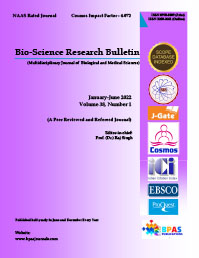Solanum betaceum: An Underutilized but Potential Tree Species with Anticancer Activity
DOI:
https://doi.org/10.48165/Keywords:
Solanum betaceum, Underutilized, PotentialAbstract
The North-East India is rich in fruit diversity and contains more than one-third of the country’s total diversity. Tamarillo or tree tomato (Solanum betaceum) is a small tree, underutilized but potential crop, cultivated for its edible fruit. It is a neglected, fast-growing, small fruit tree produces edible fruits with high content of vitamins, minerals, phenolic and carotenoids compounds as well as low carbohydrates content. In India, tamarillo grows in the hilly regions of north eastern states, hilly areas of West Bengal and Maharashtra, including Uttarakhand, Himachal Pradesh and Nilgiri hills because of the cool climatic condition in which the crop can sustain. Tamarillo is a new source of pectin with potential applications as thickeners/gelling agents depending on solvent or applied processes. This adds commercial value to the fruit and promotes further application for its pectin as a food additive. Amongst the fruits, only tamarillo mesocarp contains both polar (anthocyanins) and non-polar (carotenoids) pigments. The ability to retain both polar and non-polar pigments in the mesocarp is related to the unique properties of its hydrocolloids. High content of carotenoids found in tamarillo fruits with 4.4 mg/100 g. The current market value of commercially used carotenoids is estimated at nearly $1.2 billion in 2010, with a chance to grow to $1.4 billion in 2018 with a compound annual growth rate of 2.3%. Purple red variety of tamarillo is endowed with antioxidant phytochemicals, which provide protection against oxidative stress induced diseases. FT-IR analysis revealed the presence of alkanes, carboxylic acid, phenol, alkanes, carboxylic acids, aromatics and nitro compounds. Supercritical fluid extracts from tamarillo epicarp is used as protectors against lipid oxidation of cooked beef meat. This extract is displayed as an option of use for this agroindustrial residue, which provide added value to the fruit, helping to strengthen its supply chain. The tamarillo shows selective cytotoxicity towards liver hepatocellular carcinoma (HepG2) and non-hormone dependent breast carcinoma (MDA-MB-231) but not on normal mouse fibroblast cells (3T3) suggests that tamarillo is potentially a good anti-cancer agent since it is non-toxic towards normal cells. It also acts as a cytotoxic agent against selected cancer cell lines. Tamarillo contains lectins which are a group of proteins of non-immune origin that bind carbohydrates specifically and non-convalently. Theflavonoids in tamarillo are of great importance, since they act as antioxidants with the ability to scavenge radicals by an electron transfer process. The scavenging effect of tamarillo is attributed to its superior total phenol content. It has an antinociceptive effect on the visceral inflammatory pain related model. Type-I arabinogalactans (polysaccharides) is responsible, at least in part, by the anti
References
. Do Nascimento, G. E., Corso, C. R., Paula Werner, M. F., Baggio, C.H., Iacomini, M. and Cordeiro, L. M. C., Carbohydr. Polym., 2015, 116, 300-6.
. Jaramillo, K., Dawid, C., Hofmann, T., Fujimoto, Y. and Osorio, C., J. Agril. Food Chem., 2011, 59(3), 975–983.
. Li, Z., Scott, K., Hemar, Y., Zhang, H. and Otter, D., Food Chem., 2018, 256, 228–234. [4]. Giuffrida, D., Zoccali, M., Arigó, A., Cacciola, F., Osorio C. Roa., Dugo, P., Mondello, L., Arch. Biochem. Biophys., 2018, 646, 161–167.
